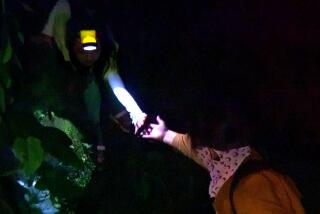TV REVIEW : ‘Near Death’ Tells Truth About the Big Lie
Death is not a candy-colored, blitzkrieg of explosions, gunshots and plot conveniences to rub out the bad guys by the end of the hour. That is television’s form of the Big Lie.
Death is slow, painful, unexpected and, often--considering its tragic consequences--outrageously banal. That is the truth, and perhaps only the unflinching master of the documentary film, Frederick Wiseman, could put it on television.
He has, with “Near Death,” the longest (six hours), perhaps most elegantly powerful film Wiseman has ever made. It airs Sunday at 11 a.m. on KVCR Channel 24 and at 1 p.m. on KCET Channel 28.
That, of course, is saying a lot. With such epic, coolly conceived films as “High School” and “Law and Order,” Wiseman has pushed the documentary form to the limit, inviting our eyes to view pockets of American life we’ve never seen--or would prefer not seeing.
This implies taboos, and we would still prefer averting our eyes from those suffering in an intensive care unit. The new film puts us inside the ICU ward at Boston’s Beth Israel Hospital, where Wiseman’s cameras track the course of four seemingly terminal patients.
The issues at the heart of “Near Death” unfold as slowly and as starkly as the patients’ conditions. Both contain surprises: The doctors and nurses find, from time to time, the ethical and medical ground moving under their feet, and not all of the patients fade into inexorable deterioration. This is about being near death, after all.
Nothing gratuitous, then, not even when the camera ponders the families in the waiting room (they reportedly gave Wiseman permission to film so that others may better prepare for the grueling experience). Far from being a death watch, the film confronts medicine’s most central current dilemma: Has advanced technology’s ability to sustain life--even when that life has no meaning or quality--made a mockery of a doctor’s life-preserving mission?
Dr. Weiss (no first names are used), the ward’s attending physician, and the staff around him spend astonishing amounts of time discussing this, or the immediate condition of the patient, or how best to gently break the bad news to the family. The fate of one patient--Mr. Cabra, a 35-year-old father and victim of pulmonary fibrosis--seems to push the physicians close to the psychic edge: Under the nervous laughter and the clinical chatter is a death rattle they can’t quite ignore.
Wiseman may not have intended it, but his film becomes the definitive rebuttal to the claim that doctors don’t care. Dr. Taylor, a family physician, displays a remarkable bedside manner and sensitivity to people’s emotional states. The picture of him huddled with families, having to decide whether the doctors should do “everything possible” or only “comfort measure” before death comes, is a picture in quiet heroism.
But as Weiss laments at one point, what is “everything possible”? A doctor, he realizes, must maintain both hope and a sober sense of reality in the face of incurability. He says this too: “A lot of this is heavy flail for no gain.” And the costs keep going up. Where, when will it end?
Like a man who has stuck to his typewriter when all the world has gone digital, Wiseman has remained faithful to his form: black-and-white photography, shots that approach the duration of real time, and a sly taste for the unexpected. The ward becomes an enclosed world, so that when Wiseman’s camera moves outside, it’s a shock. And with the few, final, outdoor shots, Wiseman concludes with a paradoxical lifting of his metaphysical head and a resigned shrugging of his shoulders.
More to Read
The complete guide to home viewing
Get Screen Gab for everything about the TV shows and streaming movies everyone’s talking about.
You may occasionally receive promotional content from the Los Angeles Times.






